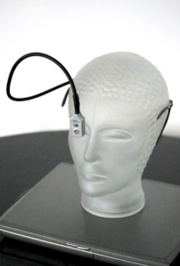Eyeborg

An eyeborg or eye-borg is a cybernetic body apparatus which typically fits on the wearer's head, and is designed to allow people to perceive color through sound waves. It is mostly used by blind people or by people with visual impairments such as color blindness or achromatopsia. It works with a head mounted camera that reads the colors directly in front of a person, and converts them in real-time into sound waves[1].
The first eyeborg was created in England in 2003 by Adam Montandon in collaboration with colourblind artist Neil Harbisson. The invention, under the heading Bridging the Island of the Colourblind Project, won a British award in Innovation (Submerge 2004)[2] and the European award in Content Tools and Interface Design (Europrix 2004)[3].
External links
- [3] Article about an eyeborg user on Wired (USA 2008)
- [4] Eyeborg user example on The Sunday Times (UK, 2008)
- [5] Information from BBC (UK, 2005)
- [6] Neil Harbisson's personal website